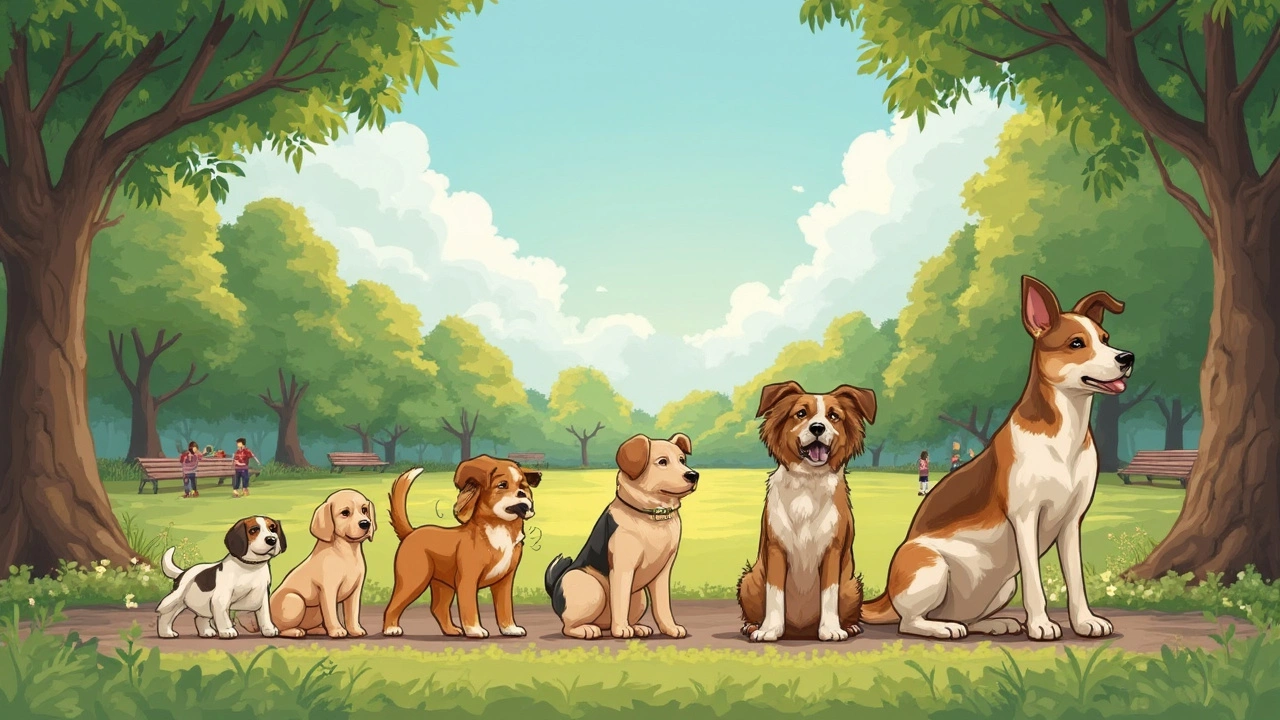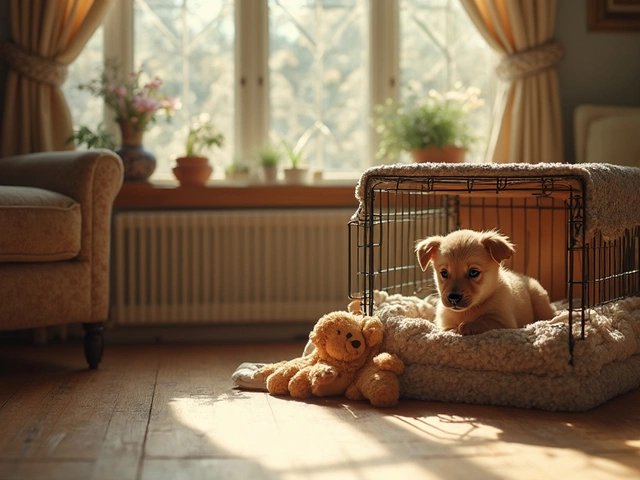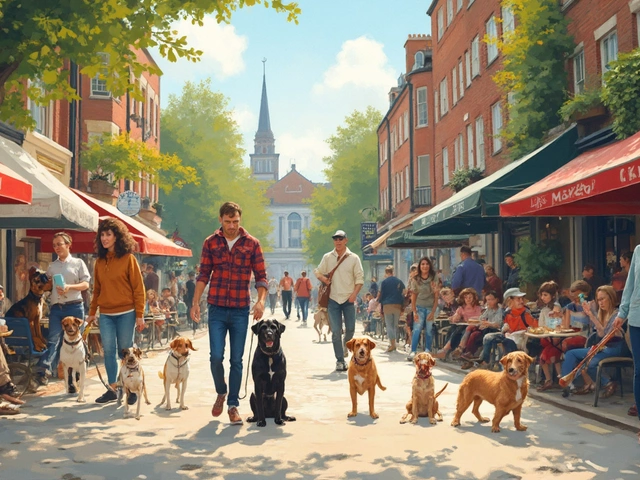Ever looked at your playful lump of fur and wondered, “When does this chaos officially become an adult dog?” You're not alone. The jump from puppy to adult isn’t as clear-cut as people think—it’s not like one day they just wake up mature. It’s a messy, gradual process, and honestly, every dog is different.
Let’s get real about what you should expect. Age is a handy guide, but it’s not the whole story. Some pups shoot up fast, others take their time. Breed matters big time, too. For starters, toy breeds might hit ‘adulthood’ right after their first birthday. Larger breeds? Sometimes, they’ll stay goofy and lanky until two years old, or even longer for the biggest giants.
If you’re raising a puppy, it’s tempting to look for an exact date when the silliness should stop. Sorry, it doesn’t really work that way. Instead, watch for changes in their body and how they act. That’s where the real clues are hiding.
- Why the line between puppy and adult can be confusing
- Age milestones: When puppies grow up
- Physical growth versus emotional maturity
- Behavioral signs your puppy is moving on
- Breed size makes a difference
- Helping your not-so-little pup through the transition
Why the line between puppy and adult can be confusing
The question of when a puppy stops being a puppy isn’t as cut-and-dry as people hope. Some folks think the first birthday is the magic mark, while others point to physical size or behavior. But here’s the deal: the shift from puppy to adult happens in steps. It’s not just about getting bigger—it’s about changes in personality, energy, and even hormones.
Veterinarians actually recognize three broad stages: puppyhood, adolescence, and adulthood. Each stage has its quirks. Puppies grow fast—sometimes gaining a pound a week—but their bones, brains, and emotions develop at different speeds. Medium to large breeds take a lot longer to grow up inside than outside. Even after a pup looks full-sized, their brain is still catching up.
There’s plenty of confusion because age, size, and behavior don’t line up perfectly. A study published in the journal "Frontiers in Veterinary Science" found that behavioral maturity in dogs can lag months, even a year or more, behind physical maturity—especially for larger breeds.
"A one-year-old dog may appear physically adult, but often displays juvenile behaviors for much longer, especially in high-energy breeds," says Dr. Lisa Radosta, board-certified veterinary behaviorist.
Plus, different organizations even use different cutoffs. For example, most vets consider dogs "adults" at one year, but the American Kennel Club says toy breeds hit adulthood at nine months, while giant breeds might not until they’re two. No wonder it gets confusing.
Bottom line: if you’re watching your own dog, you’ll see the changes don’t come all at once. It’s usually a mix of more settled behavior, training "clicking," less frantic energy, and a body that finally looks just right. If you’re not sure what to expect or when, pay attention to your dog’s cues instead of just watching the calendar.
The puppy development journey is a winding road, not a straight line. Understanding that makes the whole process a little less stressful—and more fun to watch.
Age milestones: When puppies grow up
If you’re trying to pin down when a puppy turns into an adult dog, it really boils down to age and breed size. There’s no magic number, but there are some clear markers to watch for.
Toy and small breeds (like Chihuahuas and Dachshunds) usually reach their adult stage around 9 to 12 months. Their bodies—and honestly, their attitudes—settle in way sooner than bigger dogs. Medium breeds (think Border Collies or Beagles) hit their stride between 12 to 15 months. But when it comes to large and giant breeds (like Labradors and Great Danes), they take their sweet time. You won’t see them fully “grow up” until at least 18 to 24 months.
If you’re wondering about the actual process, vets and experts tend to agree that a dog’s first year is packed with growth spurts and puppy craziness. By their first birthday, most dogs are losing their baby teeth, their limbs look a bit more proportional, and they can handle longer walks without crashing. But that’s not the whole story. Especially for bigger breeds, their bones and joints keep developing well into their second year.
Here’s a quick breakdown:
- Puppy development: Small breeds — adult at 9-12 months
- Medium breeds — adult at 12-15 months
- Large/giant breeds — adult at 18-24 months, sometimes even later
If you’re filling out forms at the vet, they’ll usually call your dog an adult by their first birthday—but don’t be surprised if your oversized “puppy” is still clumsy or acts like a goof. That’s totally normal for some breeds. These milestones aren’t just numbers—they help you decide when to switch food, start tougher training, or adjust exercise. Always go at your dog’s pace, and when in doubt, ask your vet for advice backed up by your dog’s growth chart.
Physical Growth Versus Emotional Maturity
It’s easy to spot when your puppy gets bigger—suddenly they don’t fit on your lap, and you’re buying new collars every other month. But just because your pup looks like a full-grown dog doesn’t mean they’re emotionally there yet. This is where people get tripped up: puppy development is about both the body and the brain, and these two don’t always sync up.
Most puppies finish growing physically between 8 and 24 months, depending on the breed. For example, Chihuahuas and Yorkies can be done by 9 months, while Great Danes and Mastiffs might still be gaining muscle past their second birthday. Check out how this usually goes:
| Breed Size | Physical Growth Ends | Emotional Maturity |
|---|---|---|
| Toy/Small | 8–12 months | Around 12 months |
| Medium | 12–18 months | 12–18 months |
| Large/Giant | 18–24+ months | 18–36 months |
So, your lab might look pretty adult-sized by one year, but mentally, they’re still working it out and might act puppyish right through eighteen months or even longer. This is where patience comes in. Emotional maturity means more stable moods, better focus, and fewer outbursts over stuff like the doorbell or a squirrel.
Worried yours is stuck in puppy mode? Here’s what to watch for to tell the difference:
- Physically mature dogs have their adult teeth, filled-out bodies, and don’t “grow out” of crates anymore.
- Emotionally mature dogs handle surprises better, listen more reliably, and can chill on their own without causing trouble.
- If your dog still pulls wild zoomies after every meal or needs non-stop attention, they might still be catching up emotionally—even if they look huge.
Don’t rush this part. Good socializing and plenty of mental exercise help speed up emotional growth. Focus on training, play, and letting them experience the world (safely). The more patiently you handle the awkward stages, the sooner you’ll get to enjoy living with a grown-up dog, in every sense.

Behavioral signs your puppy is moving on
So, how can you actually tell when your puppy is starting to grow up? The most obvious changes aren’t always physical—they’re in the way your dog acts. Here’s what you’ll notice when your pup is heading out of the puppy stage and stepping into a bigger dog mindset.
First, biting and mouthing usually chill out. Puppies use their mouths for everything, just like human babies. When you start noticing those nips and chews drop off—usually between 6 to 12 months—it’s a big sign your furball is maturing. Play might still get a little wild, but it shouldn’t hurt so much anymore.
Next up: the zoomies slow down. Young puppies have those wild bursts of energy and go from napping to tearing across the house in a blink. As your dog edges closer to one year (sometimes two for giant breeds), you’ll see the frequency and craziness of these episodes fading. Don’t worry, older dogs still play—they just do it with a little more control.
You’ll also see your dog being more interested in learning and focusing, especially on you. Distracted puppies often find every leaf, rock, and shadow more interesting than their owner. As maturity sets in, attention spans get longer. Training starts to finally stick, and recall gets way more reliable. This is way more obvious in breeds bred for work or sports.
Social behavior changes, too. Puppies love absolutely everyone and everything at first. Older dogs get a little pickier. They might become more reserved around unfamiliar dogs or strangers. If your once super-social puppy starts acting a little shy or cautious, that’s a normal part of growing up.
Here’s a quick look at common behavioral milestones:
| Age Range | Behavioral Change |
|---|---|
| 8-16 weeks | Biting/mouthing peaks, high energy, short attention spans |
| 4-6 months | Teething ends, less chewing, training makes slow progress |
| 6-12 months | Less mouthing, more focus on owners, energy outbursts decrease |
| 12-24 months | Settling down, longer focus, clearer grown-up personality |
Here’s one thing to remember: not all puppies follow this timeline. Some might still act like goofballs at two years old. And certain breeds (hey, Labrador lovers) keep that silly streak way into adulthood. But keeping an eye on these behavioral changes gives you a real sense of when that chaotic puppy phase is winding down.
When you spot these changes, ramp up the training and give them bigger challenges. This is the perfect time for advanced obedience, puzzle toys, and trying out new activities together. It helps build a strong bond and brings out their best adult dog self. And if you’re wondering about puppy development, these milestones are your best cheat sheet.
Breed size makes a difference
Here’s something a lot of new dog owners don’t realize—puppyhood doesn’t last the same amount of time for every dog. Your Pomeranian and your neighbor’s Great Dane are on totally different timelines. The main reason? Size. Breeds grow and mature at their own speed, and it’s usually tied to how big they get when fully grown.
Let’s break down the general pattern:
- Small breeds (like Chihuahuas or Maltese) often hit maturity fast. Think as early as 9 to 12 months old. You’ll notice their growth levels off, and some even start to act more like adult dogs before their first birthday. That means you’ll need to switch up everything from their food to training plans a lot earlier than with big pups.
- Medium breeds (think Cocker Spaniels or Bulldogs) usually shift out of puppy mode by about 12 to 15 months. You’ll see them fill out, settle down (at least a little), and their energy becomes more manageable. This is when a lot of bad mouthing and chewing starts to fade.
- Large and giant breeds (like Golden Retrievers, Labs, or Mastiffs) are the slowpokes here. Many aren’t done growing (in both body and attitude) until 18 to 24 months. Some truly giant breeds, like Great Danes, can keep maturing up to 3 years. If you’ve got one of these, don’t expect the puppy stage to end quickly.
Why does this matter for puppy development? Because forcing a small breed to keep eating puppy food too long can pack on the pounds, while pushing a giant breed to adult food too soon can mess with bone growth. Plus, knowing your dog’s timeline helps you set better expectations for behavior. You get less frustrated, and your dog gets what they actually need at each stage.
Bottom line—watch your dog, and keep their breed’s usual timetable in mind. Celebrate the little milestones, and don’t panic if your goofy teen dog is still bouncing off walls at an age where your friend’s small dog has totally chilled out.
Helping your not-so-little pup through the transition
The jump from puppy to adult is a weird phase. Suddenly your dog is bigger and stronger, but still tries to squeeze into your lap like a chubby baby. This stage isn’t just about size—your dog’s mind, hormones, and habits are all shifting. If you want a chill, happy adult dog, what you do right now matters a lot.
Here’s what works best when your rapidly-growing pup is heading into adult territory:
- Stay on top of training. Even if they’ve nailed “sit” and “stay,” this phase brings new tests. Teen dogs push limits. Keep short practice sessions, add trickier commands, and reward good stuff right away.
- Ditch the same-old puppy food once your vet says so. Puppies need fattier, richer formulas, but too many calories for too long = overweight adults. Switch to regular adult food when they reach about 80% of their adult size, or as your vet recommends. For a puppy development chart by breed, see below.
- Up exercise—but not to the moon. Young dogs still have growing bones and joints. Vets recommend two shorter walks rather than one marathon session. Try gentle hikes, fetch, or tug games made for their strength and breed.
- Socialize, then socialize more. Awkward teen dogs need new faces—both humans and animals. Join group classes, meet neighbors’ dogs, or just go people-watching at the park.
- Vet visits aren’t just for shots. This is when most dogs need to be spayed/neutered if you haven’t done it already. Your vet will check their weight, joints, and any odd behaviors at the same time.
- Set house rules and be consistent. If you let the “puppy pass” slide too long, your dog will think chewing socks is forever cool. Decide where they can sleep, what furniture is off-limits, and stick with it.
Want some numbers? This table gives you an idea when most dogs are ready for adult dog food and training challenges:
| Breed Size | Switch to Adult Food | Socialization Peak | Often Neutered/Spayed |
|---|---|---|---|
| Tiny/Small (Chihuahua, Yorkie) | 9-12 months | 3-10 months | 6-12 months |
| Medium (Beagle, Border Collie) | 12-14 months | 3-12 months | 8-14 months |
| Large/Giant (Lab, Great Dane) | 14-24 months | 3-14 months | 10-24 months |
This period is all about finding the balance—enough freedom to grow, but firm boundaries so your almost-adult knows what’s okay. It’s normal for these growing dogs to get barky or ignore commands they used to do perfectly. Patience and consistency are key. Reward the calm, adult-like behavior you want to keep seeing, and remember: most dogs do settle down by two years old, even if they act like wild toddlers until then.







